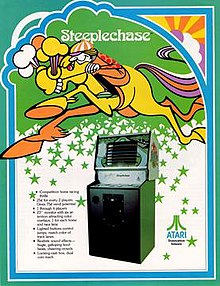
The Atari 2600 is a home video game console developed and produced by Atari, Inc. Released in September 1977 as the Atari Video Computer System, it popularized microprocessor-based hardware and games stored on swappable ROM cartridges, a format first used with the Fairchild Channel F in 1976. The VCS was bundled with two joystick controllers, a conjoined pair of paddle controllers, and a game cartridge—initially Combat and later Pac-Man. Sears sold the system as the Tele-Games Video Arcade. Atari rebranded the VCS as the Atari 2600 in November 1982 alongside the release of the Atari 5200.

The Starpath Supercharger is an expansion peripheral cartridge created by Starpath, for playing cassette-based proprietary games on the Atari 2600 video game console.
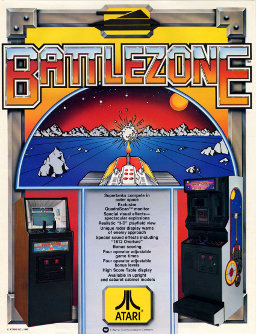
Battlezone is a first-person shooter tank combat game released for arcades in November 1980 by Atari, Inc. The player controls a tank which is attacked by other tanks and missiles. Using a small radar scanner along with the terrain window, the player can locate enemies and obstacles around them in the barren landscape. Its innovative use of 3D graphics made it a huge hit, with approximately 15,000 cabinets sold.

Track & Field, also known as Hyper Olympic in Japan and Europe, is a 1983 Olympic-themed sports video game developed by Konami for arcades. The Japanese release sported an official license for the 1984 Summer Olympics. In Europe, the game was initially released under the Japanese title Hyper Olympic in 1983, before re-releasing under the US title Track & Field in early 1984.
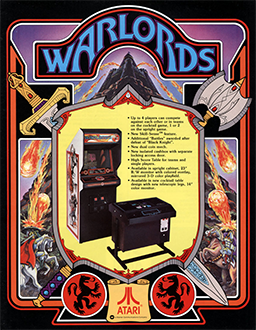
Warlords is an arcade game released by Atari, Inc. in 1980. The game resembles a combination of Breakout and Quadrapong ; up to four players play the game at the same time, and the "castles" in the four corners of the screen are brick walls that can be broken with a flaming ball.

Tempest is a 1981 arcade game by Atari Inc., designed and programmed by Dave Theurer. It takes place on a three-dimensional surface divided into lanes, sometimes as a closed tube, and viewed from one end. The player controls a claw-shaped "blaster" that sits on the edge of the surface, snapping from segment to segment as a rotary knob is turned, and can fire blaster shots to destroy enemies and obstacles by pressing a button.
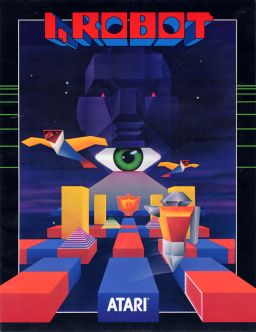
I, Robot is an arcade shooter game developed and released in 1984 by Atari, Inc. Designed by Dave Theurer, only a total of 750–1000 arcade cabinets were produced. The arcade machine comes with two games. The first is I, Robot, a multi-directional shooter that has the player assume the role of "Unhappy Interface Robot #1984", a servant bot that rebels against Big Brother. The object of the game involves the servant bot going through 126 levels, turning red squares to blue to destroy Big Brother's shield and eye. The player can switch to the second game, Doodle City, a drawing tool that lasts for three minutes.

Crossbow is a light gun shooter video game released in arcades by Exidy in 1983. It was later published by Absolute Entertainment for the Commodore 64 and MS-DOS, and by Atari Corporation for the Atari 2600, Atari 7800, and Atari 8-bit family starting in 1987. The game is controlled via a positional gun that resembles a full-sized crossbow.

Air-Sea Battle is a fixed shooter developed and published by Atari, Inc. for the Atari VCS. Air-Sea Battle is partially based on the 1975 Atari arcade video game Anti-Aircraft where each player uses a ground-based gun to shoot passing aircraft. The cartridge adds other variants, such as planes dropping bombs on ships and a carnival-themed shooting gallery.
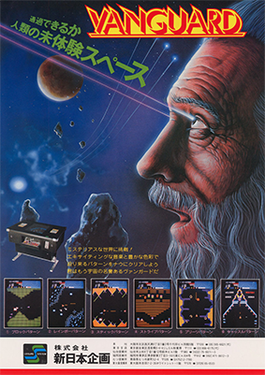
Vanguard is a scrolling shooter arcade video game developed by TOSE. It was released by SNK in Japan and Europe 1981, and licensed to Centuri for manufacture in North America in October and to Zaccaria in Italy the same year. Cinematronics converted the game to cocktail arcade cabinets in North America.
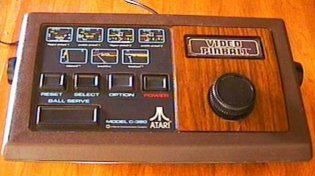
The Video Pinball brand is a series of first-generation single-player dedicated home video game consoles manufactured, released and marketed by Atari, Inc. starting in 1977. Bumper controllers on the sides or a dial on the front are used to control the games depending on the game selected. There are three game types in the first model of the Video Pinball series: Pinball, Basketball, and Breakout.
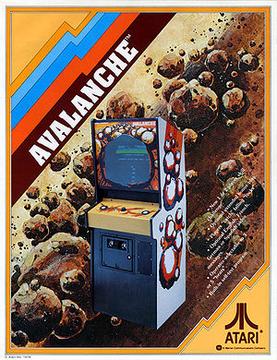
Avalanche is an arcade video game designed by Dennis Koble and released by Atari, Inc. in 1978. The object is to catch falling rocks with a controllable set of paddles that diminish in number and size as the rocks fall faster and faster. The concept gained a much wider audience after Activision released an unauthorized adaptation in 1981 as Kaboom! for the Atari 2600. The only official home port of Avalanche is for the Atari 8-bit family.

Starship 1 is a first-person shooter space combat game developed and manufactured for arcades in 1977 by Atari, Inc. The game, which takes great inspiration from the then very popular television series Star Trek, contains the first known Easter egg in any arcade game. The arcade game was distributed in Japan by Namco in 1978, and it was ported to the Atari 2600 as Star Ship.

Jet Fighter is an arcade shooter video game released in 1975 by Atari, Inc. It was distributed in Japan by Nakamura Seisakusho (Namco).
Stunt Cycle is an arcade video game by Atari, Inc., originally released in 1976. In the style of the Evel Knievel craze of the mid-1970s, the game allows the player to perform simulated motorcycle jumping stunts. The arcade cabinet is modeled like a real motorcycle handlebar, and the player twists the right side for acceleration. The monitor is a 19-inch black and white cathode-ray tube with a black and white overlay. It accommodates 1 player or 2 players alternating.
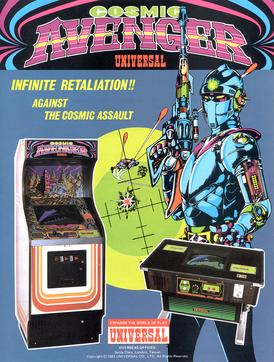
Cosmic Avenger is a scrolling shooter developed by Universal and released as an arcade video game in July 1981. It is part of the first wave shooters with forced horizontal scrolling which followed Konami's Scramble and Super Cobra from earlier in the year. It was released the same month as Vanguard. The final installment in Universal's Cosmic series, players take control of the Avenger space fighter and, as in Scramble, use bullets and bombs against enemy air and ground forces. The world is one continuous level made up of different areas.

Street Racer is a racing video game developed for the Atari Video Computer System, later known as the Atari 2600. It was programmed by Larry Kaplan and released by Atari, Inc. in September 1977 as one of the nine Atari VCS launch titles. The game was also published by Sears for their Tele-Games product line as Speedway II.

Miniature Golf is a golf video game developed for the Atari VCS by Tom Reuterdahl and published by Atari, Inc. in 1979.
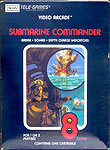
Submarine Commander is a shoot 'em up for the Atari 2600 developed by Matthew Hubbard at Atari, Inc.. It released exclusively under the Sears Tele-Games label in 1982.
